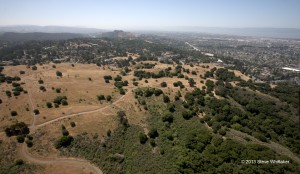The East Bay Express has published an in-depth article about the zoo’s expansion plans in Knowland Park called “Zoo Gone Wild.”
The park was deeded to the City by the State of California on the condition that it remain a public park forever. But in a major change to its proposed expansion project, Zoo management will now ask the City Council to approve an unprecedented request to put a “no trespassing” encumbrance on 52 acres of Knowland Park land, as the “mitigation” required by regulatory agencies for Zoo management’s poor choice to build their project in the wrong place—on high-value plant and wildlife habitat.
We are grateful for the fine work of the investigative journalist, and to the conservation organizations who spoke out against this ill-conceived expansion plan: Sierra Club SF Bay Chapter, Center for Biological Diversity, East Bay Chapter of the California Native Plant Society, California Native Grasslands Association, and the Resource Renewal Institute.
This thoroughly researched article offers a rare opportunity for us to get the full story out to the public. We encourage you to help spread the word.
HERE’S WHAT YOU CAN DO:
PROMOTE the article:
Email the East Bay Express link to the article to your family, friends and neighborhood listservs. If you’re on Facebook, please Share it from our Save Knowland Park Facebook page, or post it directly on your own FB page (higher impact if you share from our SKP FB page).
COMMENT on the article: They made it their cover story—help keep it active by posting a comment, if only to thank them for devoting the time and space to research and report on the Zoo’s controversial expansion plan location.
SPEAK UP: Let the City Council know you care about saving Knowland Park!
Corrections to Zoo CEO Joel Parrott’s comments in the article’s video:
Dr. Parrott (video at 1:32–): “This maritime chaparral will remain untouched, undamaged.”
FACT: Any suggestion that Knowland Park’s rare maritime plant community will not be touched or damaged by this project is absolutely false. Fire management regulations require cutting a 30 ft. wide strip of maritime chaparral along the perimeter fence down from a height of 5-6 ft. to 18 inches; if the City and State decide to enforce actual legal fire management requirements, a 100-ft. wide strip cut to 18 inches would be required. Construction of the gondola towers and perimeter fence will negatively impact the maritime chaparral, as will the proximity of access roads and the 100+ person overnight camp facility, exposing it to degradation from invasive weeds. The zoo has a history of facilitating and allowing the spread of invasives in the park, and has done almost no remediation.
Dr. Parrott (at 2:05–): “The project has purposefully left a view point for park hikers.”
FACT: What the project actually does is push people out of the most beautiful hiking areas in the park. It fences off one spectacular view point for zoo access only, and leaves one knoll at the bottom of a steep graded fire road that will be boxed in between the residential area on the south border of the park and the zoo’s 8 ft. chain-link perimeter fence (topped with 3 ft of barbed wire) that will run right alongside the knoll. Instead of the peaceful natural surroundings there now, the one park-accessible view point will be degraded by that fence, and the zoo’s nearby facilities and accompanying noise.
Dr. Parrott (at 4:02–): The site for a 3-story interpretive center is “a former fill-site” covered with invasive weeds.
FACT: This site is the zoo’s illegal manure dump. The zoo “planted” the invasive weeds, which are now invading the maritime chaparral, and it has never made any effort to undo the damage. Friends of Knowland Park’s weed removal work has included removing and carting out many bags of invasive weeds from this area.
Dr. Parrott (at 5:00–): The 400 remaining acres of Knowland Park “will forever be set aside for hiking.”
FACT: The zoo refuses to make any binding promise to refrain from developing the rest of the park, and its past promises to set aside certain areas for trails, views and other park purposes have been repeatedly broken. It has also repeatedly manipulated acreage numbers to hide what it is doing now: zoo management needs to check their math. The zoo currently sits on ~100 fenced acres at the western end of Knowland Park, only half of which is being used now by the zoo; that leaves about 400 acres of natural park land above the zoo; the zoo’s project will take away the best 77 acres, which means only about 320 acres of the park will be left. And as long as the City allows it, that parkland is not protected from zoo development.

 Follow
Follow








Comments are closed.